Huawei Technologies E3735 HSPA Express Data Card User Manual
Huawei Technologies Co.,Ltd HSPA Express Data Card
Contents
- 1. User manual
- 2. User manual Appendix rev
- 3. User manual appendix rev
User manual Appendix rev
Additional Flyer
Federal Communication Commission Interference Statement
15.19
NOTICE:
This device complies with Part 15 of the FCC Rules [and with RSS-210 of Industry
Canada].
Operation is subject to the following two conditions:
(1) this device may not cause harmful interference, and
(2) this device must accept any interference received, including interference that may
cause undesired operation.
15.21
NOTICE:
Changes or modifications made to this equipment not expressly approved by
(manufacturer name) may void the FCC authorization to operate this equipment.
15.105
NOTE: This equipment has been tested and found to comply with the limits for a Class B
digital device, pursuant to Part 15 of the FCC Rules. These limits are designed to provide
reasonable protection against harmful interference in a residential installation. This
equipment generates, uses and can radiate radio frequency energy and, if not installed
and used in accordance with the instructions, may cause harmful interference to radio
communications. However, there is no guarantee that interference will not occur in a
particular installation. If this equipment does cause harmful interference to radio or
television reception, which can be determined by turning the equipment off and on, the
user is encouraged to try to correct the interference by one or more of the following
measures:
Reorient or relocate the receiving antenna.
Increase the separation between the equipment and receiver.
Connect the equipment into an outlet on a circuit different from that to which the
receiver is connected.
Consult the dealer or an experienced radio/TV technician for help.
FCC Caution: Any changes or modifications not expressly approved by the party
responsible for compliance could void the user's authority to operate this equipment.
This device complies with Part 15 of the FCC Rules. Operation is subject to the following
two conditions: (1) This device may not cause harmful interference, and (2) this device
must accept any interference received, including interference that may cause undesired
operation.
IMPORTANT NOTE:
Radiation Exposure Statement:
This equipment complies with FCC radiation exposure limits set forth for an uncontrolled
environment. End users must follow the specific operating instructions for satisfying RF
exposure compliance. To maintain compliance with FCC RF exposure compliance
requirements, please follow operation instruction as documented in this manual.
This transmitter must not be co-located or operating in conjunction with any other antenna
or transmitter.
SAR compliance has been established in typical laptop computer(s) with Express card
slot, and product could be used in typical laptop computer with Express card slot. Other
application like handheld PC or similar device has not been verified and may not
compliance with related RF exposure rule and such use shall be prohibited.
The availability of some specific channels and/or operational frequency bands are country
dependent and are firmware programmed at the factory to match the intended destination.
The firmware setting is not accessible by the end user.
CAUTION:
The Express Data Card has been tested with specific integral antenna for SAR
compliance with one notebook computers.
The device can be used in notebook computers with substantially similar physical
dimensions, construction, and electrical and RF characteristics.
Note: If this Express Data Card is intended for use in any other portable device, you are
responsible for separate approval to satisfy the SAR requirements of Part 2.1093 of FCC
rules.
This transmitter and its antenna(s) must not be co-located or operating in conjunction with
any other antenna or transmitter.
1
Safety Information
Read the safety information carefully to ensure
the correct and safe use of your wireless device.
Interference
Do not use your wireless device if using the
device is prohibited or when it cause danger or
interference with electric devices.
Medical Device
y Do not use your wireless device and follow
the rules and regulations set forth by the
hospitals and health care facilities.
y Some wireless devices may affect the
performance of the hearing aids. For any such
problems, consult your service provider.
y If you are using an electronic medical device,
consult the doctor or device manufacturer to
confirm whether the radio wave affects the
operation of this device.
Area with Inflammables and
Explosives
To prevent explosions and fires in areas that are
stored with inflammable and explosive devices,
do not use your wireless device and observe the
rules. Areas stored with inflammables and
explosives include but are not limited to the
following:
y Gas station
y Fuel depot (such as the bunk below the deck
of a ship)
y Container/Vehicle for storing or transporting
fuels or chemical products
y Area where the air contains chemical
substances and particles (such as granule,
dust, or metal powder)
y Area indicated with the "Explosives" sign
y Area indicated with the "Power off
bi-direction wireless equipment" sign
y Area where you are generally suggested to
stop the engine of a vehicle
Traffic Security
y Observe local laws and regulations while
using the wireless device. To prevent
accidents, do not use your wireless device
while driving.
y RF signals may affect electronic systems of
motor vehicles. For more information,
consult the vehicle manufacturer.
y In a motor vehicle, do not place the wireless
device over the air bag or in the air bag
deployment area. Otherwise, the wireless
device may hurt you owing to the strong
force when the air bag inflates.
2
y Observe the rules and regulations of airline
companies. When boarding, switch off your
wireless device. Otherwise, the radio signal
of the wireless device may interfere with the
plane control signals.
Safety of Children
Do not allow children to use the wireless device
without guidance. Small and sharp components
of the wireless device may cause danger to
children or cause suffocation if children
swallow the components.
Environment Protection
Observe the local regulations regarding the
disposal of your packaging materials, used
wireless device and accessories, and promote
their recycling.
WEEE Approval
The wireless device is in compliance with the
essential requirements and other relevant
provisions of the Waste Electrical and
Electronic Equipment Directive 2002/96/EC
(WEEE Directive).
RoHS Approval
The wireless device is in compliance with the
restriction of the use of certain hazardous
substances in electrical and electronic
equipment Directive 2002/95/EC (RoHS
Directive).
Laws and Regulations
Observance
Observe laws and regulations when using your
wireless device. Respect the privacy and legal
rights of the others.
Care and Maintenance
It is normal that your wireless device gets hot
when you use or charge it. Before you clean or
maintain the wireless device, stop all
applications and disconnect the wireless device
from your PC.
y Use your wireless device and accessories
with care and in clean environment. Keep the
wireless device from a fire or a lit cigarette.
y Protect your wireless device and accessories
from water and vapor and keep them dry.
y Do not drop, throw or bend your wireless
device.
y Clean your wireless device with a piece of
damp and soft antistatic cloth. Do not use any
chemical agents (such as alcohol and
benzene), chemical detergent, or powder to
clean it.
y Do not leave your wireless device and
accessories in a place with a considerably low
or high temperature.
y Use only accessories of the wireless device
approved by the manufacture. Contact the
3
authorized service center for any abnormity
of the wireless device or accessories.
y Do not dismantle the wireless device or
accessories. Otherwise, the wireless device
and accessories are not covered by the
warranty.
Specific Absorption Rate
(SAR)
Your wireless device is a radio transmitter and
receiver. It is designed not to exceed the limits
for exposure to radio waves recommended by
international guidelines. These guidelines were
developed by the independent scientific
organization ICNIRP and include safety
margins designed to assure the protection of all
persons, regardless of age and health.
The guidelines use a unit of measurement
known as the Specific Absorption Rate, or SAR.
The SAR limit for wireless devices is 2.0 W/kg
and the highest SAR value for this device when
tested complied with this limit.
Regulatory Information
The following approvals and notices apply in
specific regions as noted.
CE Approval (European Union)
The wireless device is approved to be used in
the member states of the EU. The wireless
device is in compliance with the essential
requirements and other relevant provisions of
the Radio and Telecommunications Terminal
Equipment Directive 1999/5/EC (R&TTE
Directive).
Federal Communications Commission Notice
(United States): Before a wireless device model
is available for sale to the public, it must be
tested and certified to the FCC that it does not
exceed the limit established by the
government-adopted requirement for safe
exposure.
The SAR limit adopted by the USA and Canada
is 1.6 watts/kilogram (W/kg) averaged over one
gram of tissue. The highest SAR value reported
to the FCC for this device type was compliant
with this limit.
FCC Statement
This device complies with Part 15 of the FCC
Rules. Operation is subject to the following two
conditions: (1) this device may not cause
harmful interference, and (2) this device must
accept any interference received, including
interference that may cause undesired
operation.
* This device should be installed and operated
with a minimum distance of 20 cm between the
radiator and your body when using it via USB
cable.
4
Version: V100R001_02
Part Number: 31220741

Quick Start Guide
Vodafone Mobile Connect
Card with 3G broadband
Designed
for Vodafone

Welcome
to the world of mobile communications
1Welcome
2 Set up your card
3 Start the software
4 Software overview
5 Connect
6 SMS text messaging
8 SMS contacts
9 Card LED lights
9 Signal strength
10 Hints and tips
12 Glossary

1
Your new Vodafone Mobile Connect Card with
3G broadband lets you connect your computer to the
internet over the Vodafone high-speed mobile phone
network.
Browse the web
You can now access the web and any other internet service
wherever there’s a mobile phone network .
Pick up emails
Keep up to date with your emails, wherever you are. You
can also access your personal email accounts – even web-
based accounts like Hotmail.
Send and receive SMS text messages*
You can send and receive SMS text messages straight
from your computer. Vodafone SMS provides an easy way
to view messages, write new ones, and manage contact
details.
System Requirements
To use this card and the Vodafone Mobile Connect
software, you need:
–
A computer running Microsoft® Windows Vista™,
Windows® XP SP2 or Windows® 2000, or an Apple Mac
running Mac OS® X 10.3.9 or above
– At least 50 MB free disk space and 256 MB RAM memory
– An ExpressCard™ slot
– Administrator rights on your computer.
Welcome
* SMS is currently only supported on computers running Microsoft Windows.
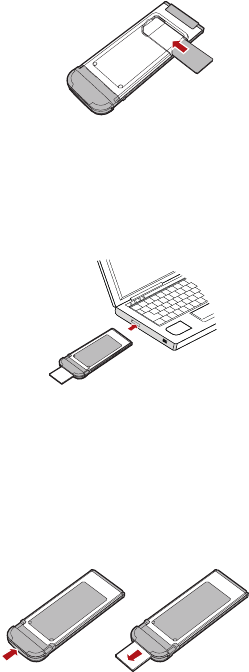
2
• Insert the SIM into the card as shown.
• Insert the data card with a SIM card into the
ExpressCard slot of a laptop.
• The low profi le data card has a built-in aerial – simply
press the end and it will extend. When you have
fi nished, push it back into the data card until it clicks.
Set up your card
Your SIM (Subscriber
Identity Module is the
small, postage-stamp-sized
chip that you received
together with your mobile
subscriber contract.

3
On Microsoft Windows computers
The fi rst time you plug your card into a PC the software
setup should start automatically, and proceed to set up
your card. If for some reason the setup does not start, right
click on the VMC Lite 9.3.x.x drive in ‘My Computer’ (Start
Menu, Computer for Vista machines), select Explore and
double-click the fi le called setup.exe on the card. Follow
the on-screen instructions.
Setting up your card may take a few minutes, but once
the setup is fi nished, the Vodafone Mobile Connect Lite
software should start automatically. If for some reason the
program does not start, select Vodafone Mobile Connect
from the Windows Start menu.
On Mac OS X computers
The fi rst time you plug in your card, it will show up on
your desktop like a standard memory stick. From the card
window, double-click the fi le called Vodafone MC Installer,
and follow the on-screen instructions.
Once your Mac has restarted, the card will no longer
appear, but you will see the Vodafone Mobile Connect
software in your Applications folder. Double-click the
program to set up a mobile connection.
Start the
software
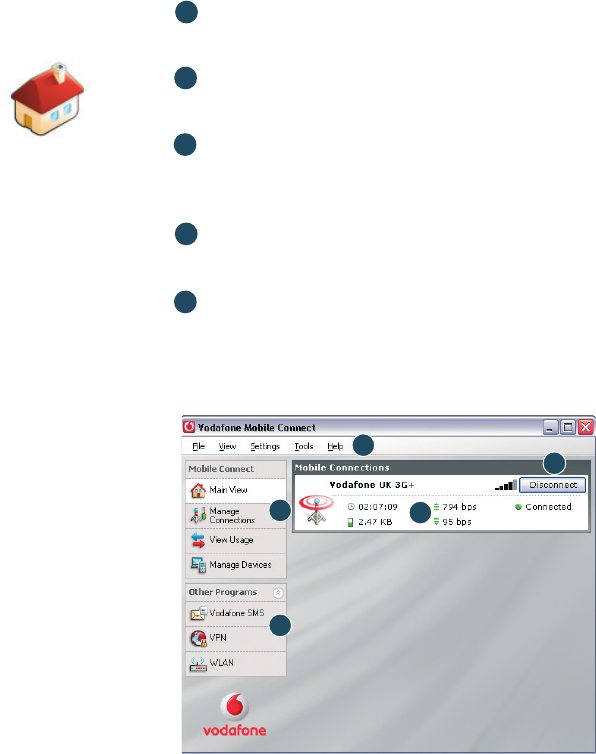
Connect/Disconnect
Connect via the mobile phone network
Views
View data usage, and additional software settings
Start SMS program
Send, receive and manage SMS messages and
contacts
Status
Check the status of your connection
Help
Help Topics, plus internet and hotline support.
4
Software
overview
5
1
4
2
3
4
3
5
1
2
The first time you
run the software,
your card will
usually be set as the
default device. If it
is not, click ‘Manage
Devices’ and select
your card there.
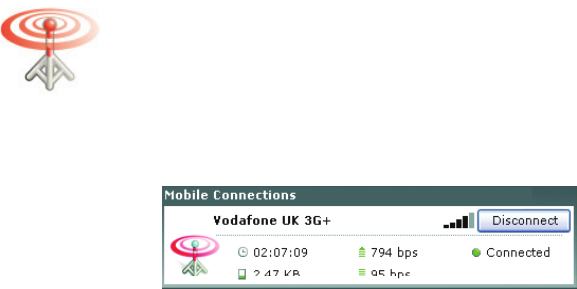
5
The radio waves on the
Mobile Connections
icon are animated
whenever data is being
transferred over the
connection.
No radio waves are
shown when nothing is
being transferred.
The radio waves are
shown static when no
connection is open.
If a mobile network has been found, the Connect button
in the Mobile Connections panel will be enabled. Clicking
Connect connects to the internet across the mobile phone
network. Now you can browse the web or use email.
When connected, the Connect button text changes to
Disconnect and a green ‘Connected’ indicator appears
below the button.
Clicking the Disconnect button will close the connection
– and the text on the button will revert to Connect.
To open a mobile connection, you need to be within
coverage of a mobile network. As a rule, anywhere you
can make a call on your mobile phone, you should be able
connect.
Connect
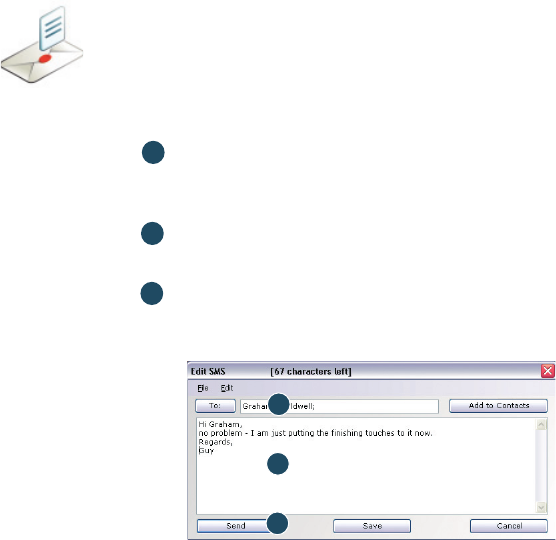
6
Click Vodafone SMS on the navigation bar in the main
window of the Vodafone Mobile Connect Lite software
to open the SMS program.
To send an SMS
Click New at the left-hand end of the SMS toolbar to
create a new SMS text message.
Address
Enter the recipients here, or choose them from
Contacts
Message
Write your message here
Send
Click on the Send button to send your message.
After your SMS has been sent, it will be stored in the
Sent list.
SMS Text
Messaging
2
1
3
The number displayed to
the person who receives
your message will be from
your data SIM, not your
mobile phone. Use a short
‘signature’ to make sure
people know you sent
them a message: Settings/
Messages/Signature.
2
1
3
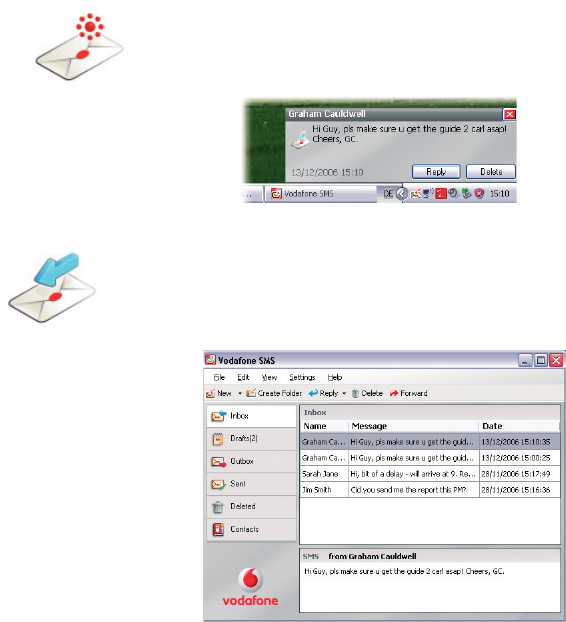
7
Receiving SMS
When you receive a new message, an SMS Notifi cation is
shown briefl y so you can respond to it directly.
The received message can also be read from the Inbox in
the main Vodafone SMS window.
The Vodafone SMS software
will receive text messages
whenever you have mobile
network coverage.
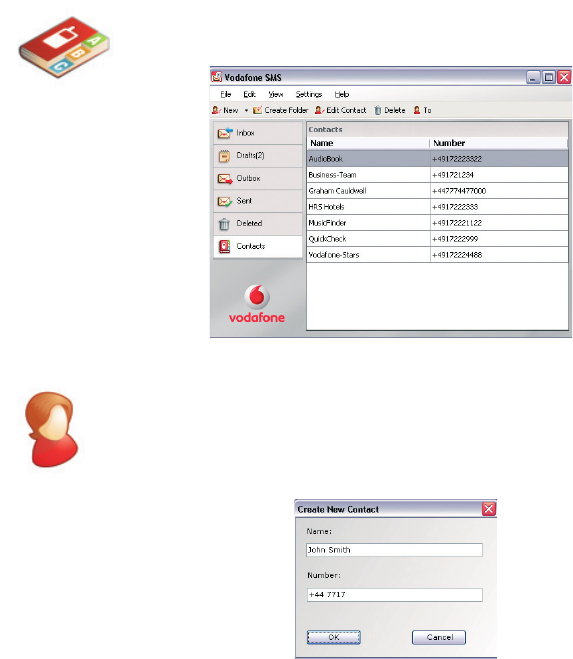
8
SMS Contacts Click Contacts on the SMS navigation bar to open the
Contacts list, in which you can save SMS numbers that
you use frequently as contacts with names.
New SMS Contact
Clicking the New button on the SMS toolbar opens a
new contact window.
Enter the name and
number of your contact
using the international
format for the number,
eg. +447774477000.

9
Card LED
lights
Signal strength
The LED light on your card shows which kind of mobile
network has been found, and whether the card is
connected to that network.
Green blinking
A GPRS network has been found – you could connect
Green solid
Connected via GPRS
Blue blinking
A 3G network has been found – you could connect
Blue solid
Connected via 3G
Light blue solid
Connected via 3G Broadband.
The strength of the mobile network signal is shown by the
symbol to the left of the Connect button, and by the icon
in the Windows Notifi cation area.
The more bars that are fi lled in, the better the mobile
network signal quality. At least one bar must be fi lled in
order to connect.
10
Hints and tips If you don’t see your card in the list of devices
– Remove the card
– Re-start your computer
– Re-insert the card.
If no network can be found
– Change your physical location: in a building, move
closer to a window, move higher up, or go outside
– (Windows) Select ‘View/View Available Mobile
Connections’ and see if you can connect to a
particular network in the list shown
– Contact Support, and check that data services and
roaming are enabled on your account.
If no connection can be opened
– Wait a few minutes and try to connect again. This
is most often a temporary problem, especially
if an ‘Error 631’ or ‘Error 619’ is referenced. If it
persists please call Vodafone Support on the
number on the next page
– Select ‘File/Exit’ to exit the Vodafone Mobile
Connect Lite software completely, and then
re-start it again
– Re-start your computer
– (Windows) Click ‘Manage’, select your device,
click edit and then select a different network
preference on the Network Preference tab page,
eg. ‘3G Only‘
– (Mac) Start the Vodafone Mobile Connect
software, and select one of the other options in
the lower part of the main window, eg. ‘3G Only‘
– If you are using a VPN (Virtual Private Network),
contact your company IT administrator.
If you have problems when roaming
– (Windows) Select ‘View/Available Mobile
Connections’ and try opening one of the
connections shown
– Contact Support, and check roaming is enabled for
your account
11
For further help, please
visit www.support.
vodafone.com, or call
Vodafone Support on
XXX or XXXXXXX.
– Check the name of the current network in the Mobile
Connections panel. If it is not Vodafone or a Partner,
select a different network from ‘View/Available
Mobile Connections’.
If the connection keeps switching between GPRS
and 3G
– (Windows) Click ‘Manage Devices’, select your
device, click edit and then select a different network
preference on the Network Preference tab page,
eg. ‘3G Only’’
– (Mac) Start Vodafone Mobile Connect, and select
one of the other options in the lower part of the main
window
– Switch back to your normal preference when you
move locations.
If you are using a Windows machine and VMCLite does
not install and/or the install progress bar keeps looping,
this can indicate a failure with Windows detecting the
device components
– Go to Device Manager (normally located under
Control Panel and System headings. Refer to Windows
Help and Support for further information on how to
access Device Manager)
– Expand the ‘Universal Serial Bus Controllers’ heading
– Right click the ‘USB Mass Storage Device’ and select
‘Uninstall’
– Once done if the devices do not automatically reload
go to ‘Action’ and ‘Scan for Hardware changes’
– If this still does not resolve please contact Vodafone
Support.
Check software update preferences
– Set your operating system and other programs
to notify you of software updates instead of
downloading them automatically – otherwise they
may slow down your mobile connection, or exceed
your data usage limit.
Usage indication
– The usage window only displays an indication of your
data usage. Please refer to your invoice for the actual
amount of data transferred.
12
Glossary Built-in
data card
Mobile data card built into notebook computer.
Enables data connections over the mobile phone
network.
Data card/
USB stick
A device for a computer that is used to open a
data connection over the mobile phone network.
EDGE An enhancement to GPRS networks offering
higher speeds, although not as fast as those
provided by 3G, or 3G Broadband.
EV-DO A high-speed mobile data standard used mostly
in the USA. Frequent travellers to the USA should
contact their mobile network operator about
using special Vodafone Mobile Connect data
cards and software in the USA.
GPRS Standard for transferring data over mobile phone
(GSM) networks. It generally provides wide
coverage and moderate data speeds. (General
Packet Radio System).
GSM A standard for mobile telecommunications
(Global System for Mobile communications),
supported by over 680 operators in 210 countries
and territories.
3G Often referred to as the 3rd Generation of
GSM technologies, UMTS (Universal Mobile
Telecommunications System) provides higher
data speeds.
3G broadband An evolution of 3G to provide faster data speeds.
Like many fi xed-line ‘broadband’ services,
3G broadband provides a faster download speed
than upload speed.
Roaming Connecting via networks other than your own
operator’s network. This typically occurs when
you are abroad, but is also possible in your own
country.
SIM The ‘Subscriber Identity Module’ is the small,
postage-stamp-sized chip that you will have
received together with your mobile subscriber
contract. The SIM has gold contacts on one side.


© Vodafone 2008. Vodafone and the Vodafone
logos are trade marks of the Vodafone Group.
Any product or company names mentioned
herein may be the trade marks of their
respective owners.
Product Code:
E3735 VMCLite 9.3 05/08-DVD_en_GB